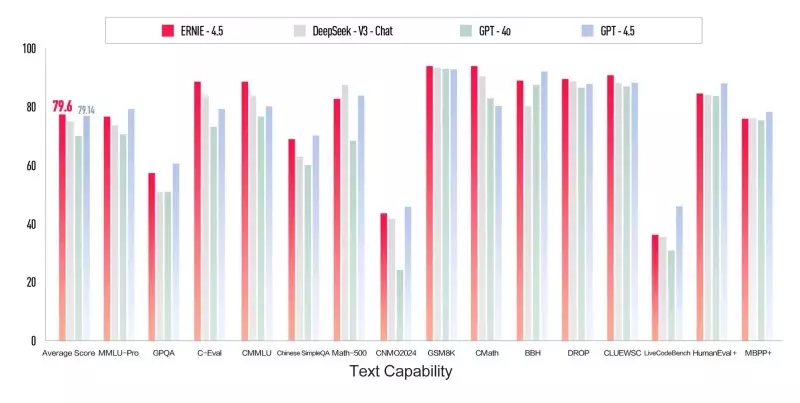Over the past weekend, Baidu, the Chinese search engine powerhouse, made headlines with its unveiling of two groundbreaking AI models: ERNIE 4.5 and ERNIE X1. The magnitude of this development cannot be overstated; these models promise to push the boundaries of existing artificial intelligence technology, embedding new benchmarks for both multimodal capabilities and advanced reasoning. While Baidu rightly claims superiority over competitive models, such as DeepSeek’s V3 and OpenAI’s GPT-4.5, the announcement sets the stage for an intriguing spotlight on the evolving landscape of AI.
What’s particularly fascinating about these new models is their aggressive pricing strategy. Baidu claims that ERNIE X1 can deliver its reasoning functionalities at an astonishing 50% less than DeepSeek’s cutting-edge model, while the ERNIE 4.5 model reportedly offers its advanced capabilities at a staggering 99% lower cost than GPT-4.5. This pricing disparity raises questions about the sustainability of competition between these titans, further fueling the race for AI dominance.
Outstanding Performance Metrics
Both ERNIE models are touted as efficient solutions that excel in various benchmarks, including C-Eval, CMMLU, and GSM8K. These tests evaluate Chinese AI performance across a wide array of subjects and tasks, asserting the developers’ commitment to cultivating competitive strength in natural language processing and reasoning capacities. Yet, the benchmarks alone do not define the capabilities; they emphasize how far Baidu has come in tightening its grip on multimodal interpretations—processing not just text, but images, audio, and videos too.
Even though ERNIE 4.5 appears to outperform GPT-4.5 across multiple metrics, it’s worth mentioning that the model’s context limit stands at a notably modest 8,000 tokens. In comparison, OpenAI’s flagship model boasts a mind-boggling 128,000-token capacity, raising concerns about whether ERNIE 4.5 will be suitable for more complex applications, most likely relegating it to tasks like customer service and more straightforward query responses rather than deep analytical jobs.
Advanced Reasoning Capabilities of ERNIE X1
What’s most intriguing is Baidu’s introduction of ERNIE X1, a model specifically engineered for complex reasoning capabilities. Its design emphasizes understanding, planning, and evolution—an ambitious approach that could potentially set new standards for AI utility. From advanced search functionalities to dynamic code execution, ERNIE X1 is not just another cog in the AI machine but instead a tool positioned to push the envelope of what AI can achieve.
Baidu’s commitment to continually enhance ERNIE X1 through Progressive Reinforcement Learning and a reward system tailored for multi-faceted tasks demonstrates an awareness of AI intricacies. Such innovative techniques may very well contribute to the creation of an AI that is functionally versatile. This could prove indispensable for enterprises seeking to incorporate advanced AI tools into their workflows, from tech-heavy industries like legal tech to more empirical settings such as finance and customer support.
Challenges and Considerations for Enterprises
While Baidu’s offering appears enticing, it is vital for industry leaders—CIOs, CTOs, and IT specialists—to meticulously weigh the advantages against potential drawbacks. The significantly lower cost could be a boon for organizations aiming to integrate AI within their operations. However, the underlying question remains: will these models deliver comparable performance levels in real-world applications as they have demonstrated in benchmarks?
Another crucial aspect to consider is licensing and data privacy. Baidu has stated intentions to make the ERNIE 4.5 model open source by June 30, 2025. This go-ahead could increase transparency but also introduces vulnerabilities related to data compliance and privacy that organizations need to scrutinize before adopting these models for larger-scale applications.
Market Impact and Future Prospects
The introduction of ERNIE 4.5 and ERNIE X1 might be indicative of shifting tides in the AI landscape, particularly as Baidu intensifies its focus on optimizing AI technologies for the Chinese market. This enhances the viability of their foundation models among businesses operating within or targeting Chinese-speaking consumers, potentially presenting these models as superior choices in localization compared to global competitors.
As AI technology progresses, Baidu is signaling its intent to cement itself at the forefront of multimodal and reasoning-based AI advancements. The backdrop of this competitive urgency paints a picture of a rapidly evolving ecosystem where performance and cost-effectiveness hold the keys to acquisition and deployment strategies. Baidu’s commitment to enhance these models could further cultivate a thriving arena for businesses to explore advanced AI applications, fundamentally reshaping the work environments of the future.

